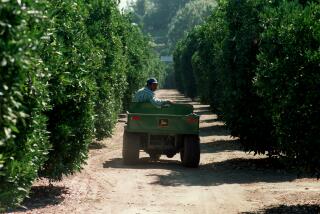Valley Cool
Every self-respecting Valleyite has endured the pejoratives and smiled stoically through the jokes--when they weren’t making the jokes themselves, that is. You know the ones we mean: the San Fernando Valley as boring bedroom community, a wasteland of tract housing and mini-malls. Years ago in a tongue-in-cheek contest, Times Valley Edition readers suggested renaming the place Beige-Air, Valle de Nada or Twenty-nine Malls.
Ouch.
But the Valley is about to get vindication.
No, we’re not talking secession, the last resort of the I-don’t-get-no-respect crowd. We’re talking admiration. We’re talking envy. We’re talking the Los Angeles Conservancy, a historic preservation group, which has come up with a revisionist view of the Valley as cool.
Yes, cool--architecturally cool. Mid-century Modern design is in, in a retro kind of way (think classic cocktails and Fiestaware), and the Valley as we know it today was born in mid-century.
The conservancy’s “How Modern Was My Valley” tour--its first of the Valley--premiered during a National Trust Conference held in Los Angeles this month. Architecture buffs from all over the country came to ooh and ah over Bob’s Big Boy in Toluca Lake (built in 1949), Casa de Cadillac in Sherman Oaks (1947), the Woodland Hills branch library (1962) and a string of other buildings many of us pass every day without a second look.
We take these buildings for granted because they’re so familiar they’ve become part of the background--and because, for many of us, they look so much like every other place we may have lived or visited.
Keep in mind, though, that the look started here. The Valley, as the conservancy points out, was one of the first planned communities in the post-World War II United States. It is home to prime examples of 1940s through 1970s Modern and Postmodern architecture and of Googie style--Bob’s Big Boy being one--designed to catch the eye of drivers in a culture increasingly dependent on the automobile.
Now approaching the 50-year mark, these buildings, “modern” as they are, have become old enough to be in again, to be fun, to be cool.
But the tour, which is being repeated for the public this weekend, has its serious side as well. It reminds us that we can lose these buildings if we fail to appreciate their uniqueness. The conservancy plainly wants to begin a community conversation about which are worth preserving and to drum up support should the wrecking ball threaten.
And the tour, while preaching an appreciation of these unrecognized architectural gems, doesn’t whitewash the problems generated by the building boom of 50 years ago. As the tour book’s epilogue points out, the era’s heavy emphasis on the automobile and on low-density development has contributed to gridlocked freeways, not to mention the disappearance of the orange groves and open spaces that predated development. Surely these are lessons for today’s building boom.
*
To Take Action: It is too late to buy tickets for today’s docent-led tour of the Valley, but you can take a self-guided tour at any time. For information and to purchase the tour booklet, call the Los Angeles Conservancy at (213) 623-2489 or go to the Conservancy Web site, www.laconservancy.org.
More to Read
The biggest entertainment stories
Get our big stories about Hollywood, film, television, music, arts, culture and more right in your inbox as soon as they publish.
You may occasionally receive promotional content from the Los Angeles Times.










